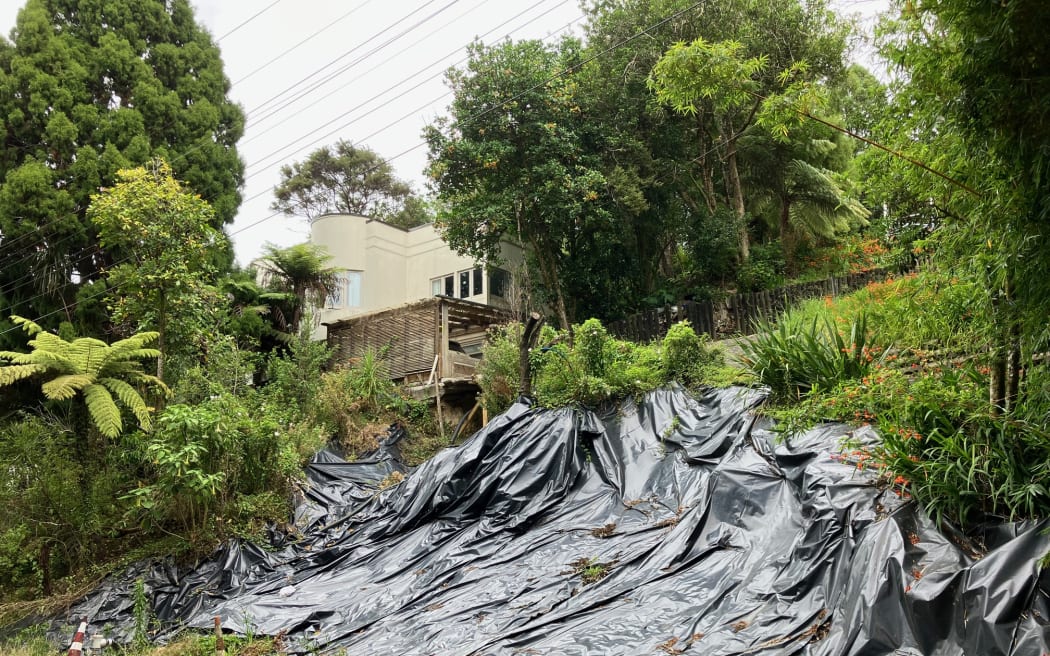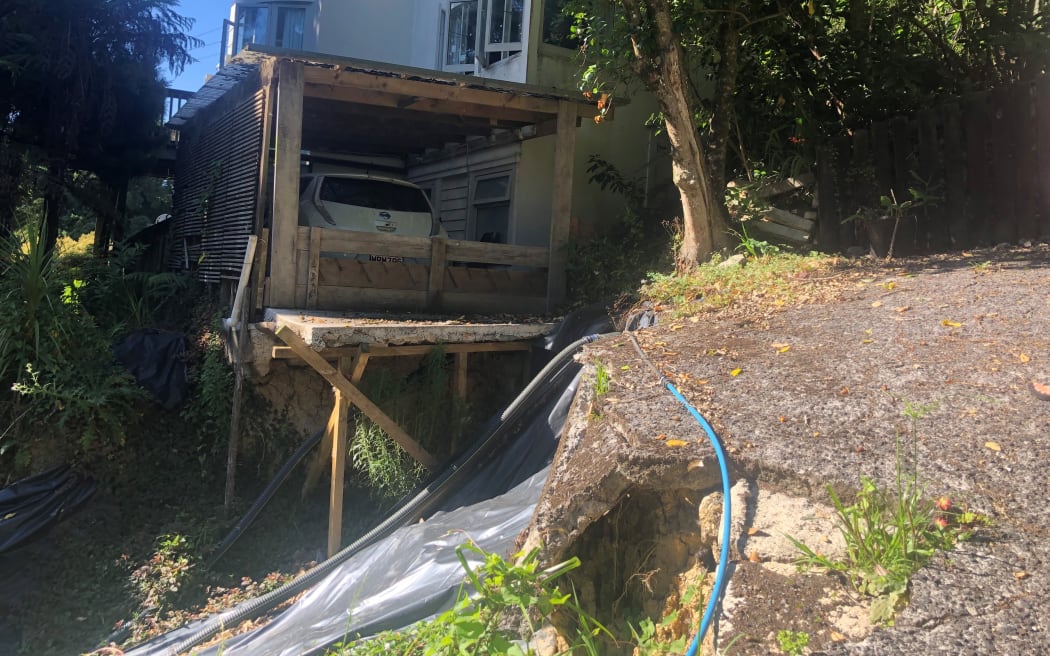More than a year on from the massive slips caused by Auckland's big stormy Anniversary weekend, hundreds of residents are still in a holding pattern over the fate of their properties. Some are facing bureaucratic nightmares and huge cash shortfalls.

Catherine Albiston on the edge of the slip that's rendered her driveway useless and her car unusable Photo: Sharon Brettkelly/The Detail
Titirangi resident Catherine Albiston is facing a $100,000 bill - or more - to build a retaining wall on council-owned land so that she can access her home.
Her driveway was swept away more than a year ago in the Auckland Anniversary weekend floods.
Her 1930s art deco house that overlooks a gully of native bush is perched above a slip covered in a large sheet of black plastic. The sheer amount of earth that came down in the landslide was enough to dislodge a big slab of concrete that now sits askew on the edge.
On the other side of the slip a carport juts out, partially hanging in the air. The carport is attached to her basement that is out of bounds for Albiston and her daughter, after a council inspector deemed it too dangerous.
Albiston has been living with this for more than a year.
She wants to fix the bank so that she can drive up to her home instead of parking on the road and climbing a steep path. It would also mean she could get her trapped car out and get into her basement.
But to fix the slip she needs to build a retaining wall on the council-owned road reserve strip next to her property and she's been told she's not eligible for any government or council finance.
Albiston says she is not the only property owner caught out.

Catherine Albiston's art deco home in Mahoe Rd, Titirangi, still shrouded in plastic wrap a year after the big slip Photo: Supplied
"In about June we all got letters saying that Auckland Transport or Auckland Council wouldn't be responsible for any repairs that were needed on their land if the purpose of it was to support our house," Albiston tells The Detail.
Albiston was then told that she would have to find and pay for engineers to assess the land and design the wall, then she would have to apply to the council for permission to build the wall on its land.
She doesn't know the exact cost of the wall because she says she would have to spend several thousand dollars for an expert assessment and quote.
"So, they've basically said we're on our own," says Albiston.
At Christmas she got the "gift" of news that she was categorised as Category 1 by the council, which means her property does not present an "intolerable risk to life" and she does not qualify for "support under the Government's framework".
She had hoped for a 2P categorisation which would entitle her to funding. When she asked for an explanation on her categorisation the council replied that it was treating that inquiry as an Official Information Act request and so far she has heard nothing.
Albiston tells The Detail that any payout from the government's EQC for land damage will be minimal because most of the slip is on the council land.
"The way EQC works is that you get the lesser of the value of the land, or the cost of the repair. I have no doubt I will get the value of the land," she says.
She is still waiting for a decision on her insurance claim but she's already been told that she won't get a payout for her car because the slip did not destroy it, it only made it inaccessible.

Catherine Albiston's car has been stranded for more than a year after a council bank slid and took away her driveway. Photo: Sharon Brettkelly/The Detail
Albiston has had to buy a new car and she says she has spent thousands of dollars on a land survey to determine boundaries and an initial geotech report.
The "possible light at the end of the tunnel" is that Auckland Transport, which is responsible for the road reserves, has told her it will seek council or government funding for her and other residents with similar cases. She is still waiting for a final decision.
"I haven't got this far in the process yet, but people say they can't even get a mortgage to cover this work (to build the wall) as the land and the retaining wall won't belong to the homeowner," she says.
"And after all this, I wouldn't even own the structure (the retaining wall) and couldn't get insurance on it."
Auckland Council's deputy group recovery manager Mace Ward told The Detail there are hundreds of similar cases in Auckland.
"We're aware of many people across the region who are in that situation where they have easements or require retaining to protect their driveways, where they're protecting their own home from either flooding or landslips, or rebuilding their building which may or may not be covered by insurance, whether that's EQC or the insurance for their property," he says.
He says Albiston has "enjoyed" the use of the easement on council land for her driveway "but the construction and the maintenance of that driveway is the beneficiary property owner's responsibility.
"Should other Aucklanders have to pay for that?"
Mace says Catherine can get help navigating the council processes but "there's no funding on the horizon at present that I can give any assurance about for those sorts of works".
Check out how to listen to and follow The Detail here.
You can also stay up-to-date by liking us on Facebook or following us on Twitter.

Photo: RNZ


